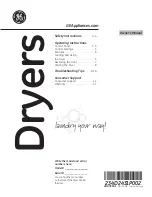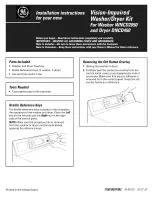
Page EN-9
Safety
■
Only leave the door slightly open to
cool down.
Damage to property
Improper handling of the appliance
may result in damage.
■
Never leave the appliance unsuper-
vised for an extended period when
the tap is on.
■
During storms or when going on holi-
day, always withdraw the mains plug
from the socket and close the water tap.
■
If there is a risk of frost, loosen the in-
let hose and allow the water to run
off.
■
Only use regenerating salt which is
suitable for dishwashers.
■
Only add dishwasher salt immediate-
ly before the next main dishwashing
cycle, as dishwasher salt which has
overfl owed can damage the seals and
fi lters of the appliance.
■
Immediately remove any spilt dish-
washer salt with a damp towel, as
otherwise the stainless steel surfaces
can be affected.
■
Ensure that the dishwashing deter-
gent and rinse aid are suitable for the
appliance.
■
Wipe away rinse aid which has over-
fl owed immediately as otherwise it
can lead to excessive foaming which
can compromise the results delivered
by the dishwasher.
■
Do not overload the appliance.
■
Position the upper dish rack at the
highest setting if very tall dishes are
in the lower dish rack, as otherwise the
upper spraying arm will be blocked.
The seals of the door are sensitive to oil
and grease.
■
Do not apply grease to the door seals.
■
Wipe away grease and oil which has
dripped onto the edge of the open
dishwasher door.
The door seals can be damaged by un-
suitable cleaning agents.
■
Do not use harsh, aggressive, sol-
vent-based or abrasive cleaners.
The appliance is designed for a water
pressure of 0.4 to 10 bar (0.04 to 1.00
MPa, 40 to 100 N/cm²).
■
If the water pressure is higher than
this, install a pressure reducer. If in
doubt, enquire about the water pres-
sure with the water supply company.
■
Never connect the appliance to the
water tap or the mixing arm of a wa-
ter heater (continuous fl ow heater,
pressure-free boiler etc.).
■
Ensure that the inlet hose is not
kinked and is carefully connected.
■
Do not cut through the inlet hose.
It contains electrical components. If
the inlet hose is damaged, have it re-
paired by a specialist.
■
Do not use old or previously installed
inlet or outlet hoses.
■
The outlet hose must be of a mini-
mum diameter of 40 mm so that the
water can be pumped away unhin-
dered.
■
Do not attach the outlet hose yourself,
have it installed by a specialist plumb-
er. Have the outlet hose checked reg-
ularly for damage or kinks.
















































